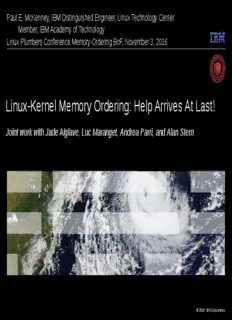
Linux-Kernel Memory Ordering: Help Arrives At Last! PDF
Preview Linux-Kernel Memory Ordering: Help Arrives At Last!
Paul E. McKenney, IBM Distinguished Engineer, Linux Technology Center Member, IBM Academy of Technology Linux Plumbers Conference Memory-Ordering BoF, November 3, 2016 Linux-Kernel Memory Ordering: Help Arrives At Last! Joint work with Jade Alglave, Luc Maranget, Andrea Parri, and Alan Stern © 2016 IBM Corporation Linux Plumbers Conference Memory-Ordering BoF, November 3, 2016 Overview Who cares about memory models? But memory-barrier.txt is incomplete! Project history Cat-language example: single-variable SC Current status and demo Not all communications relations are created equal Rough rules of thumb 2 © 2016 IBM Corporation Linux Plumbers Conference Memory-Ordering BoF, November 3, 2016 Who Cares About Memory Models? 3 © 2016 IBM Corporation Linux Plumbers Conference Memory-Ordering BoF, November 3, 2016 Who Cares About Memory Models, and If So, Why??? Hoped-for benefits of a Linux-kernel memory model –Memory-ordering education tool –Core-concurrent-code design aid –Ease porting to new hardware and new toolchains –Basis for additional concurrency code-analysis tooling Likely drawbacks of a Linux-kernel memory model –Extremely limited code size • Analyze concurrency core of algorithm • Maybe someday automatically identifying this core • Perhaps even automatically stitch together multiple analyses (dream on!) –Limited types of operations (no function call, structures, call_rcu(), …) • Can emulate some of these • We expect that tools will become more capable over time • (More on this on a later slide) 4 © 2016 IBM Corporation Linux Plumbers Conference Memory-Ordering BoF, November 3, 2016 But memory-barrier.txt is Incomplete! 5 © 2016 IBM Corporation Linux Plumbers Conference Memory-Ordering BoF, November 3, 2016 But memory-barrier.txt is Incomplete! The Linux kernel has left many corner cases unexplored The Linux-kernel memory model must define many of them Guiding principles: –Strength preferred to weakness –Simplicity preferred to complexity –Support existing non-buggy Linux-kernel code (later slide) –Be compatible with hardware supported by the Linux kernel (later slide) –Support future hardware, within reason –Be compatible with C11, where prudent and reasonable (later slide) –Expose questions and areas of uncertainty (later slide) • Which means not one but two memory models! 6 © 2016 IBM Corporation Linux Plumbers Conference Memory-Ordering BoF, November 3, 2016 Support Existing Non-Buggy Linux-Kernel Code But there are some limitations: –Compiler optimizations not modeled –No arithmetic –Single access size, no partially overlapping accesses –No arrays or structs (but can do trivial linked lists) –No dynamic memory allocation –Read-modify-write atomics: Only xchg() and friends for now –No locking (but can emulate locking operations with xchg()) –No interrupts, exceptions, I/O, or self-modifying code –No functions –No asynchronous RCU grace periods, but can emulate them: • Separate thread with release-acquire, grace period, and then callback code Something about wanting the model to execute in finite time... 7 © 2016 IBM Corporation Linux Plumbers Conference Memory-Ordering BoF, November 3, 2016 Be Compatible With HW Supported by Linux Kernel Model must be in some sense a least common denominator: –If a given system allows some behavior, the model must also do so –Note that the model can allow behavior forbidden by systems However, compiler & kernel code can mask HW weaknesses: –Alpha has memory barrier for smp_read_barrier_depends() –Itanium gcc emits ld.acq and st.rel for volatile loads and stores Key problem: How to know what does hardware do? –Check existing documentation –Consult HW architects, where available and responsive –Formal memory models, where available –Run experiments on real hardware 8 © 2016 IBM Corporation Linux Plumbers Conference Memory-Ordering BoF, November 3, 2016 Be Compatible With HW Supported by Linux Kernel Model must be in some sense a least common denominator: –If a given system allows some behavior, the model must also do so –Note that the model can allow behavior forbidden by systems However, compiler & kernel code can mask HW weaknesses: –Alpha has memory barrier for smp_read_barrier_depends() –Itanium gcc emits ld.acq and st.rel for volatile loads and stores Key problem: How to know what does hardware do? –Check existing documentation –Consult HW architects, where available and responsive –Formal memory models, where available –Run experiments on real hardware –In the end, make our best guess!!! Expect changes over time... 9 © 2016 IBM Corporation Linux Plumbers Conference Memory-Ordering BoF, November 3, 2016 Be Compatible With C11, Where Reasonable smp_mb() stronger than C11 counterpart Linux-kernel RMW atomics stronger than C11 C11 doesn't have barrier-amplification primitives –smp_mb__before_atomic() and friends C11 doesn't have smp_read_barrier_depends() C11 doesn't have control dependencies C11 doesn't have RCU grace periods –Though a proposal has been solicited and is in progress By default, support the Linux kernel's ordering needs 10 © 2016 IBM Corporation
Description: